HOW YOU REFURBISH THE MUNICIPAL BUDGET AT THE EXPENSE OF TOURISTS

Photo Source: G. Sciacca, A. Rampulla, G. Perdichizzi, R. Sultana
Since 24 November 2022, the Municipality of Noto has seen fit to "remodulate" the tourist tax to restore the municipal budget. From a range that until last summer ranged from €1 to €2 for a maximum of 4 consecutive nights, the City Council, through Resolution No. 57 of 11/24/2022, was "forced" to increase it from 2, €5 to €5 for a maximum of 6 nights.
Proportionate and gradual?
Obviously the problem does not arise for those who are willing to pay 200 or 300 euros a night in the center of Noto or for the VIP on duty. However, for a couple of students who pay 20 euros to stay in a tent in July, an extra 5 euros represents 25% of the amount, as well as for a family with two children over 14 who, in the same period, as far as regards, you would realistically pay €39 for the overnight stay and €10 for the tourist tax. Do they seem few to you?
At the turn of August, in the period of maximum tariff increase, the tourist tax would affect between 18% and 20%. Does it seem to you that there is a proportion and gradualness compared to the 3% or 5% that would weigh on the cost of those who choose to stay overnight in a hotel in the center of Noto? Fortunately, I don't run the risk of indirectly damaging the hotels in Noto, given that the maximum rate applicable by law is €5… Except in Rome, where it could theoretically go up to €10 (however, I wouldn't want the ancient privilege of the SPQN granted to Noto would push the administrators to ask for parity with the Capital…)
Pan-noticism
The "problem" of Noto is that it has the population of a town and a municipal extension, inherited from its historical coat of arms, immense (555 sq km, the first in Sicily and the fourth in Italy). For example, as far as we are directly concerned, Agricamping Sophia is just over 3 km from the center of Pachino and a good 22 km from the center of Noto: in your opinion, those who stay in our structure do so for Noto or to be close of Marzamemi? He will probably go to Noto for dinner at least once, and then take a walk on the Corso and enjoy the marvelous Baroque. However, almost nobody knows that Marzamemi falls halfway within the municipal territory of Noto, pace of a certain egocentrism... Indeed, the less informed are convinced that it is an independent municipality.
And in the neighboring municipalities, how much do you pay for the tourist tax?
As regards "open-air accommodation facilities" such as our agri-campsite (where the disproportionate incidence on tourists' pockets is greater), in Pachino you would pay €1 per night per person for a maximum of 5 nights. . In Portopalo di Capo Passero (close to Pachino) 50 cents for a maximum of 15 nights. In Avola (just over 8 km from Noto) €1 per night for a maximum of 7 nights. Rosolini (neighboring municipality, which is just under 15 km from Noto) I suspect that it has not really been established (you will forgive me for any inaccuracy but I could not find anything on the Municipality website). In Ispica (neighboring municipality) 50 cents per night. In Modica (neighbouring municipality, which certainly does not need the coat of arms of Noto to attract tourists) €1.5 per night for up to 7 nights. Finally, even in the splendid Syracuse (neighboring municipality) €1 per night for a maximum of 4 nights. Find the intruder…
Even in Taormina it costs less (€1)! Can you explain to us according to which logic the average tourist should stay in Noto and not, for example, in Avola to visit Noto? We're talking about the average tourist, the one for whom car insurance is already a major expense, not those who can afford a €3,400,000 penthouse in the center of Milan or the pop star who goes to the Town Hall of Noto to rediscover their origins.
 Loss of competitiveness
Loss of competitiveness
In this difficult period (we are emerging from a pandemic, we are in the midst of an energy and economic crisis) what should we do? Lower the rates to be competitive, thus offsetting the increase in this clever tourist tax? As if all the rest of the costs (taxes, work, bills, maintenance, etc.) were lowered as a result?
And the munnizza?
Furthermore, are we sure that Noto can afford such a drastic increase in the tourist tax? Apart from the story "Selvaggia Lucarelli" what else has it done but show what is there for all to see, that is, that the territory of Noto, especially in the summer season, is dominated by the "munnizza", read the reviews from tourists ? Here's a recent one that concerns us: <<5 stars to all the staff. 5 stars for the facility and services. 5 stars to the tranquility and common spirit of all campers to enjoy the "holiday". 0 stars to the municipal administration for waste management which unfortunately disfigures the innumerable beauties of this coast of Sicily>>. This is on average what tourists think. Talk to us with tourists or trust those who work there. We should thank them if they come back, not increase their tourist tax as an incentive! The wish is obviously that the Municipality of Noto becomes an example of care for its territory, so as to become a sort of cultural driving force for neighboring municipalities as well.
Why and when was the tourist tax introduced
It was reintroduced after a twenty-year suspension by the last Berlusconi government with the
Legislative Decree of 14 March 2011 which, in article 4, highlights without the possibility of misunderstanding that the proceeds deriving from the tourist tax must be destined to finance interventions in the field of tourism, including those in support of accommodation facilities, as well as maintenance, use, recovery of local cultural and environmental assets, as well as the related local public services. Practically, in fact, science fiction… In any case, it is not written anywhere that it serves to restore a financial crisis. It is also envisaged that the municipalities interface with the most representative associations of the owners of the accommodation facilities in order "to have further application methods of the tax, as well as to provide for exemptions and reductions for particular cases or for certain periods of time": apart from auditors, the Municipality, representing the "open-air accommodation facilities", who heard?
Another key point is that the tourist tax must be applied according to "graduality criteria in proportion to the price". I ask you: does it seem to you that there is a proportion between the €5 per person, per night, which the €200 hotel must request from the guest and the €2.5 which the €20 agri-campsite must instead request?< br>
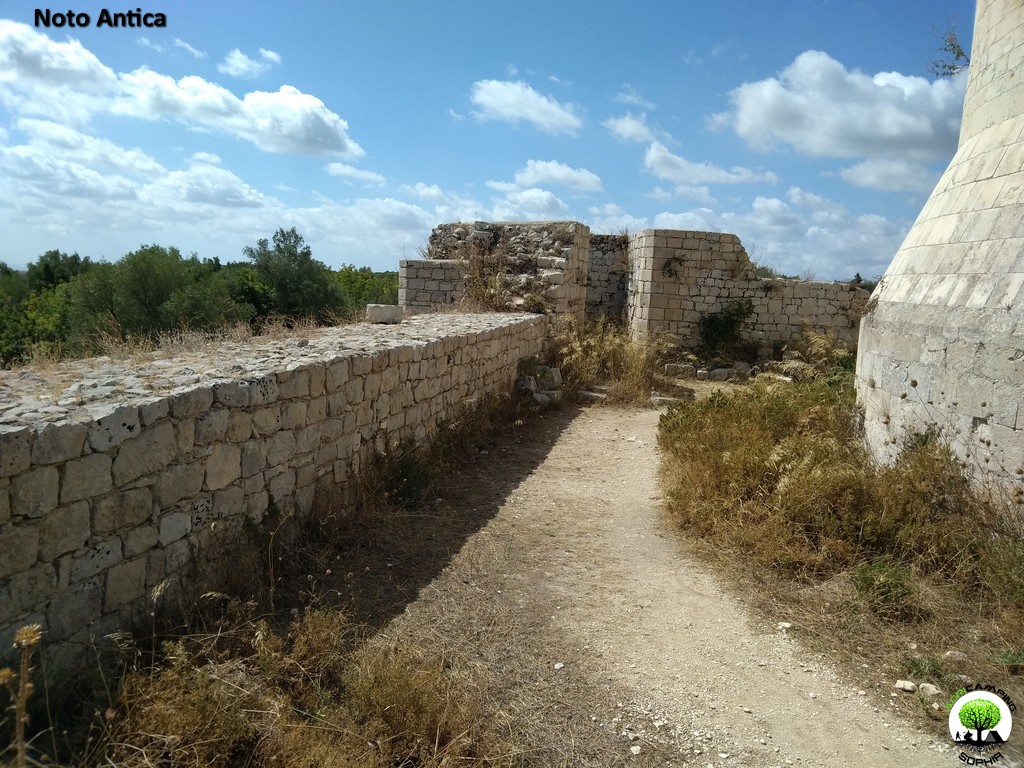 Resolution n.57 of 24/11/2022 of the Municipality of Noto< /U>
Resolution n.57 of 24/11/2022 of the Municipality of Noto< /U>
The President of the Municipal Council of Noto introduces the fifth item on the agenda:
“Financial distress - Activation of own revenue pursuant to article 251, Legislative Decree no. 267/2000 - Approval and amendment of the Tourist Tax Regulations”. Already with this premise, the suspicion is that the financial instability is associated with the modification of the tourist tax regulation or, better, that this modification takes place as a function of the financial instability. Deputy Mayor Salvatore Veneziano says: <
>. And what about the Auditors who have to do with a tax that has the specific purpose of being entirely spent on tourism?
Councilor Vincenzo Leone rightly replies: <>. In other words and more direct words, law in hand, it cannot be used to restore municipal accounts but, repetita iuvant, must be entirely invested in favor of tourism...
Councilor Leone continues heroically: <> Ah! We had the suspicion that there was no reporting by the Municipality of Noto on the "tourist" interventions financed by the revenue from the tourist tax...
Councilor Leone, at this point, wonders if the Municipal Administration actually wants to administer, deciding independently (having full power) the "remodulation" of the tourist tax regardless of the opinion of the Auditors.
The Deputy Mayor intervenes and reiterates how the request for exemption from the payment of the tourist tax from the fifth day and the reduction relating to the non-"tourist" winter months has been rejected by the Auditors: <>. Judge, I have no more questions! Clearer than that! The remodulation (i.e. the disproportionate increase of the tourist tax) takes place according to the financial instability.
The Prime Minister Pietro Rosa increases: <>. Therefore, the tourist tax would almost be the panacea for financial instability but, since it is necessary to give continuity to essential services, with the expected increase, the tourist tax, unlike in the past, will finally be able to finance tourist interventions? Count Lello Mascetti, I don't understand…
The final resolution is however very clear: <
- the recalculation of the tourist tax;
- the modification of article 2, paragraph 3 of the current regulation of the tourist tax (Institution and prerequisite of the Tax) for as follows “the tax is paid for each overnight stay in accommodation facilities located in the territory of the Municipality of Known up to a maximum of 6 [compared to the previous 4, N.d.A.] consecutive nights";
- the non-application of the 50% tax reduction in the months of January, February and November.>>
The tourist tax was therefore "remodulated", without the possibility of misunderstanding, to restore the state of financial instability. The question that must be raised is whether it can be done legally, i.e. whether the financial instability can be restored directly to the tourists, through the tourist tax.

The “Viareggio” case
Section I of the Council of State ( opinion n. 2383 of 15 November 2016) decreed that the tourist tax cannot be used to restore the budget. This opinion was requested by the hoteliers of Viareggio due to the resolution (October 2014) through which the prefectural commissioner of the Tuscan municipality applied the maximum rate allowed to the tourist tax (in this case, from €2 to €5, in relation to the type of structure), eliminating the discounts relating to seasonality. The hoteliers in question therefore complained about the loss of competitiveness against neighboring municipalities (with lower tourist taxes) and contested the legitimacy of this tourist tax increase in order to restore the municipal budget and not for tourism-related needs . Does it remind you of another case? The Council of State accepted the appeal of the hoteliers of Viareggio canceling the increase in the tourist tax.
Another legal confirmation in this regard is given by the Court of Auditors, Sicilian Section, (deliberation n. 154/2021): << Since the tourist tax is a purpose tax established by a legislative constraint, the relative proceeds must necessarily be destined to expenses envisaged by the aforesaid provision of law, as they also pertain to institutional services of the institution and this even in the presence of a situation of instability.>>
Need a detailed report
Let's make the words of Esmeralda Giampaoli our own, president of Confesercenti Versilia: «We can state that in Viareggio, a few years after the entry into force of the provision, we still do not see a concrete return on the territory, deriving from the use of this tax. That money, since this tax was created for a very specific purpose, should be reinvested in the area for the benefit of the tourist, commercial and cultural sector. This is not the case today and we will ask both that a detailed report be delivered to us, of how this tax has been invested in the past, and what ideas the administration intends to put in place for the near future".
Conclusion
Can the Municipality of Noto therefore "in order to ensure the procurement of financial resources for the recovery of the state of financial instability" remodulate the tourist tax? No, he can't do that. Text Source: Antonino Rampulla
ARCHIVE NEWS
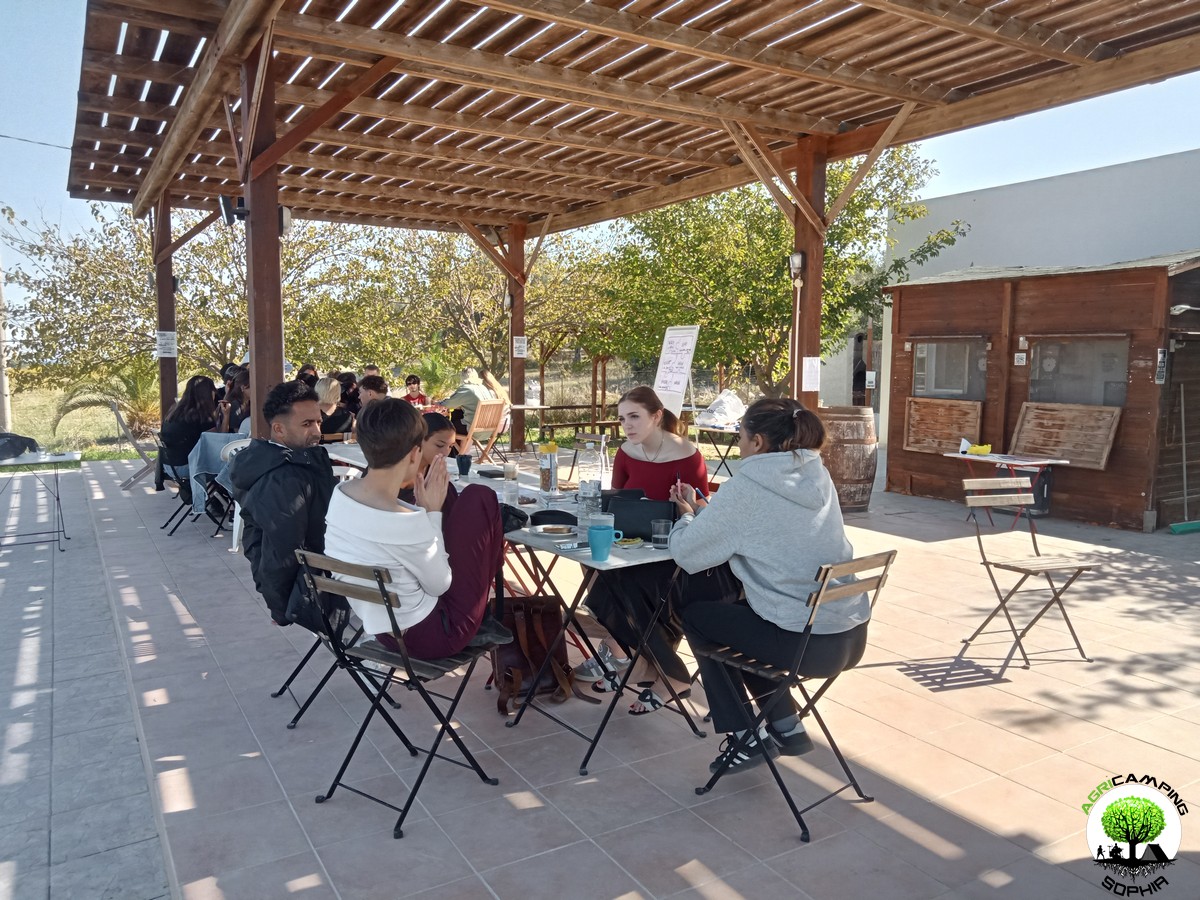 DO YOU WANT TO ORGANIZE AN ERASMUS AT AGRICAMPING SOPHIA?
DO YOU WANT TO ORGANIZE AN ERASMUS AT AGRICAMPING SOPHIA?
WHAT IS AGRICAMPING SOPHIA?
It is a campsite with tent pitches, glamping tents, mobile homes and bungalows
WHERE IS IT?
In Italy, in Sicily, near Syracuse, in Pachino: 36.736883, 15.095610
HOW TO CONTACT US?
info@agricampingsophia.it
(SPEAK ENGLISH) +39 3473079242 – (ONLY SPEAK ITALIAN) +39 3452396095
WHAT DO WE OFFER?
We offer hospitality and catering for Erasmus projects
FOR HOW MANY PEOPLE?
We can have 4-7 single beds in the Socrate Bungalow, 6-10 single beds in the Platone Mobile Homes, 4-6 single beds in the Aristotele Mobile Homes, 4 single beds in the Iblone Mobile Homes, 4 single beds in the single beds in the Empedocle Glamping Tents. In total we therefore have 18 comfortable single places or 31 single places with a fair spirit of adaptation.
IN WHICH PERIOD CAN AGRICAMPING SOPHIA BE AVAILABLE?
The most suitable periods to use our services...
 CART RUTS MODELED ON SOFT ROCK?
CART RUTS MODELED ON SOFT ROCK?
Read also RACK OR HOUSING FOR CLOGS?
Some cart ruts from the Targia district, in Syracuse, and most of the cart ruts from Granatari Vecchi, in Rosolini, give the impression of having been impressed, modelled, on a rock that was originally viscous, not entirely solid. As absurd as this hypothesis may seem, especially in Granatari Vecchi, the softness of the shapes and the at least anomalous uniformity of the rock bank, as if it were a concrete casting, which hosts the cart ruts, is unicum compared to the lithic context in the area.
In Targia this phenomenon is less impressive but if we consider the cart ruts essentially cart tracks, therefore furrowed roads indirectly resulting from the repeated passage of carts along the same route, we do not understand why such uniformity and smoothness is present, in the majority of cases, also on the parts not affected by the passage of the...
 RACK OR HOUSING FOR CLOGS?
RACK OR HOUSING FOR CLOGS?
Read also CART RUTS CUT FROM QUARRIES
In the presence of slopes, even slight ones, in some cart ruts in the Targia district, in Syracuse, central holes are found with a diameter of between 30 and 50 centimeters and a depth of 15-20 centimeters, spaced about 50 centimeters apart. Neither the position (they are not exactly in the center of the cart ruts and perfectly aligned with each other), nor the shape appear perfectly regular: either the passage of time and any wear have profoundly modified their original shape or, simply, they have never had a systematic regularity. However, the offset in position between one hole and another is never completely “off-axis”: there is always a portion about twenty centimeters wide that coincides with the same portion of the previous and subsequent hole. The best preserved and most defined holes are found in the cart ruts usually called Scala...
 CART RUTS CUT FROM QUARRIES
CART RUTS CUT FROM QUARRIES
Back to CART RUTS AND A FEW TOO MANY PROJECTIONS
I will skip any preamble, referring to what has already been written regarding the presence of cart ruts in south-eastern Sicily.
The easy academic tendency has been, in most cases concerning cart ruts, to consider them in terms of the latomie, or quarries, with which very often (for example in the cases of the Targia or Pizzuta districts) they share the same territory.
According to this theory, the carraie would have been indirectly created due to the wear of the rock at each passage of carts or sleds loaded with extracted stone blocks. I will not repeat the arguments presented so far in order to demonstrate that this is a theory that has little solid foundations on an in-depth analysis of the cart ruts. However, I will add a piece by demonstrating the implausibility of a connection between them in both chronological and functional...
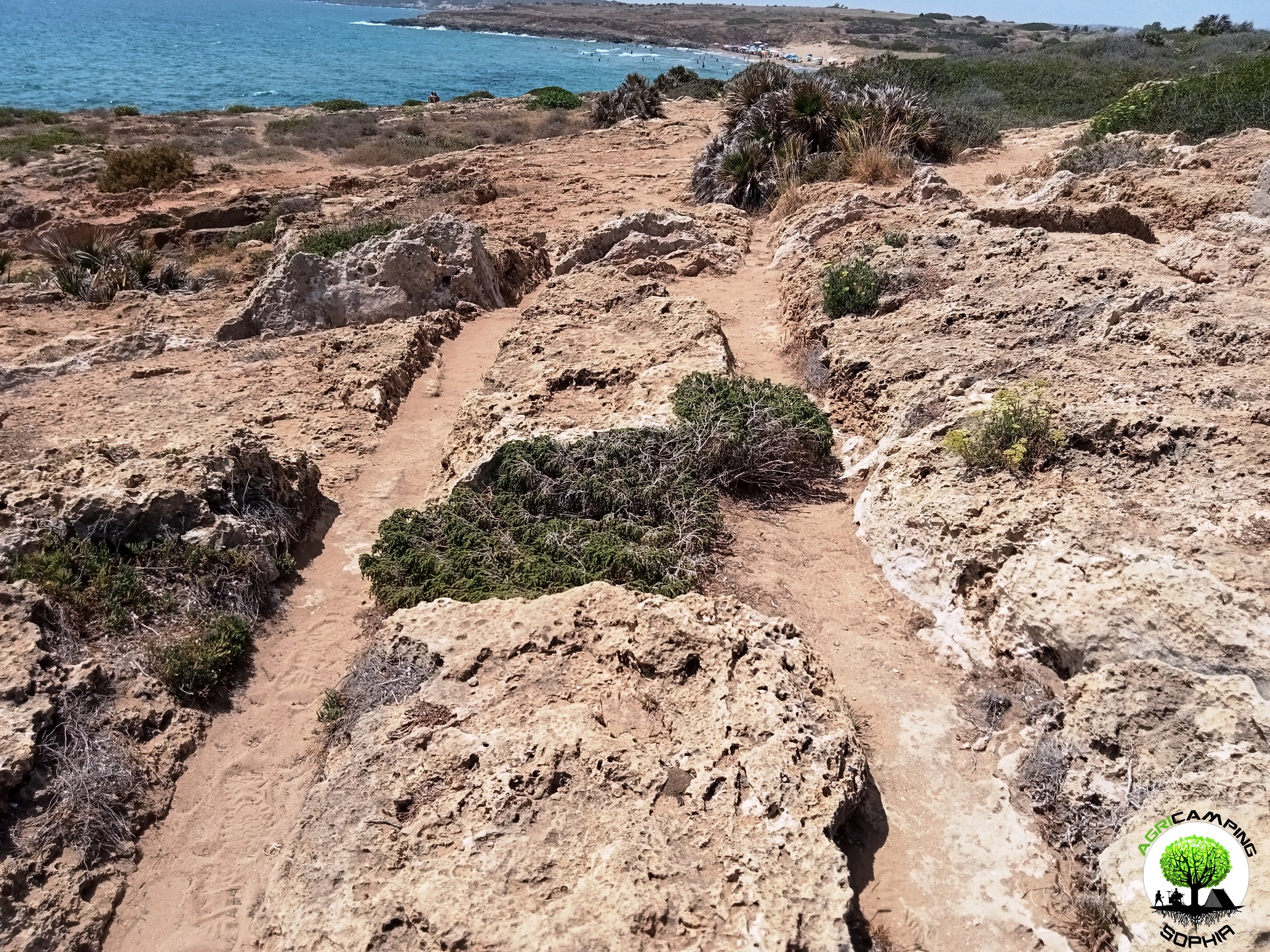 CART RUTS AND A FEW TOO MANY PROJECTIONS
CART RUTS AND A FEW TOO MANY PROJECTIONS
Read also THE POLISHING OF THE CART RUTS
I will skip any preamble, referring to to what has already been written regarding the presence of cart ruts in south-eastern Sicily.Considering the possibility that the cart ruts were gradually dug by the passage of carts pulled by pack animals, for example pairs of oxen, observing certain sections of the cart ruts present in the Granatari Vecchi district, in Rosolini, and in the Pizzuta district, close to the Vendicari Reserve, two questions arise:
1. Why force the animals to pass over rough surfaces and protrusions high, compared to the base of the furrows, even 60-70 centimeters?
2. Why, in the presence of such obstacles, not opt for a detour?
For Mottershead, Pearson and Schaefer such protrusions appeared later, since at the time of the passage of the wagons, a layer of earth covered the rocky bank, thus not making the obstacle...
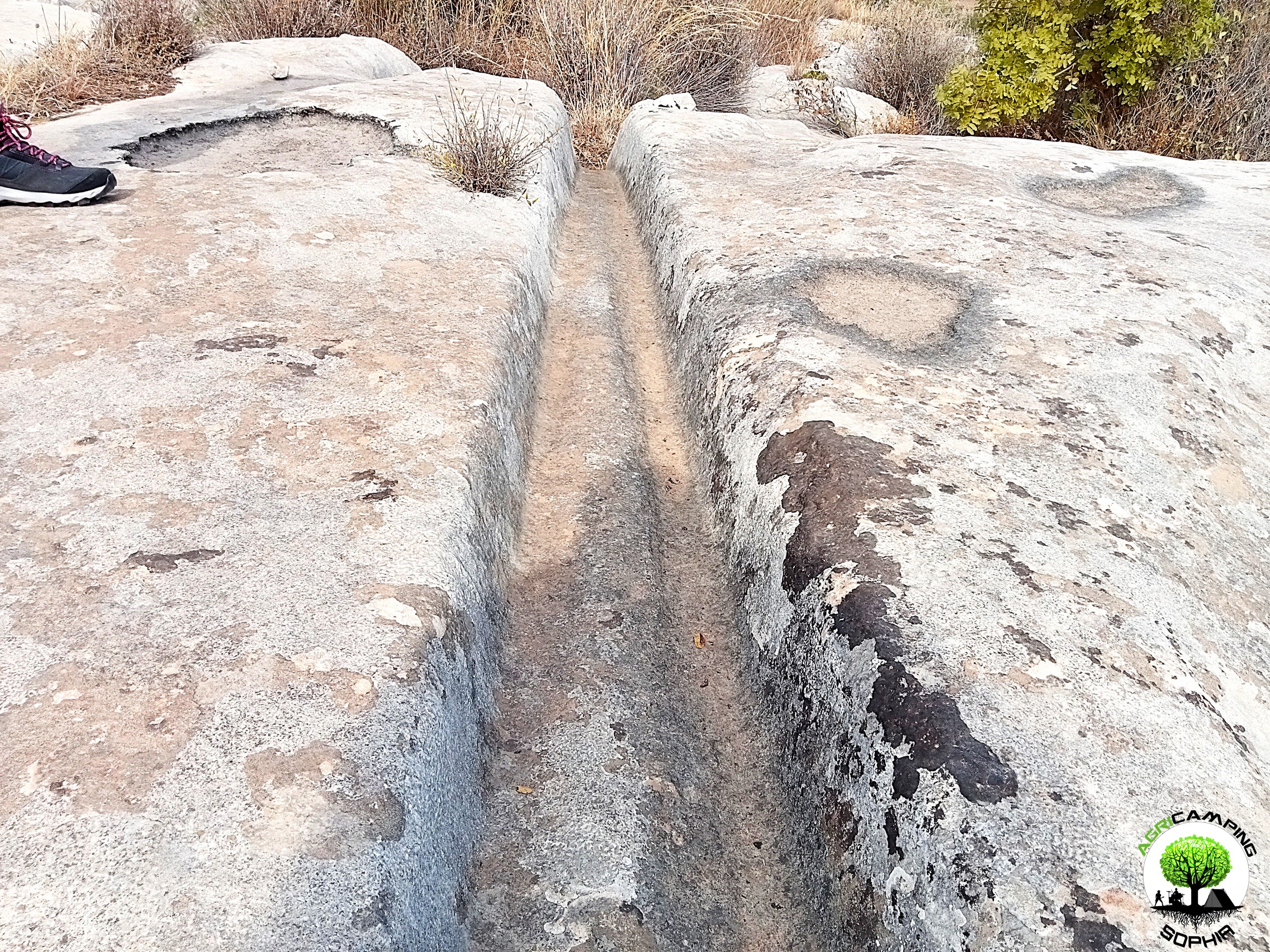 THE POLISHING OF THE CART RUTS
THE POLISHING OF THE CART RUTS
Read also THE PROBLEMATIC EDGES OF THE CART RUTS
I will skip any preamble, referring to to what has already been written regarding the presence of cart ruts in south-eastern Sicily.
To proceed with this comparison I have chosen a probable capital and the corner of a recess present in a block of the northern walls of Eloro that would seem to resemble a pinax, that is, a niche that would have housed a fresco of the heroa, but which a more careful observation refers to a system functional to the grip of the block through a pincer winch. Both elements, like the curt ruts, have remained at the mercy of the elements for millennia, and are therefore subject to comparable wear and tear due to the passage of time. The finishing of the capital should be of a high standard, since it is an architectural element that also has an aesthetic function. The recess, on the other hand, should have...
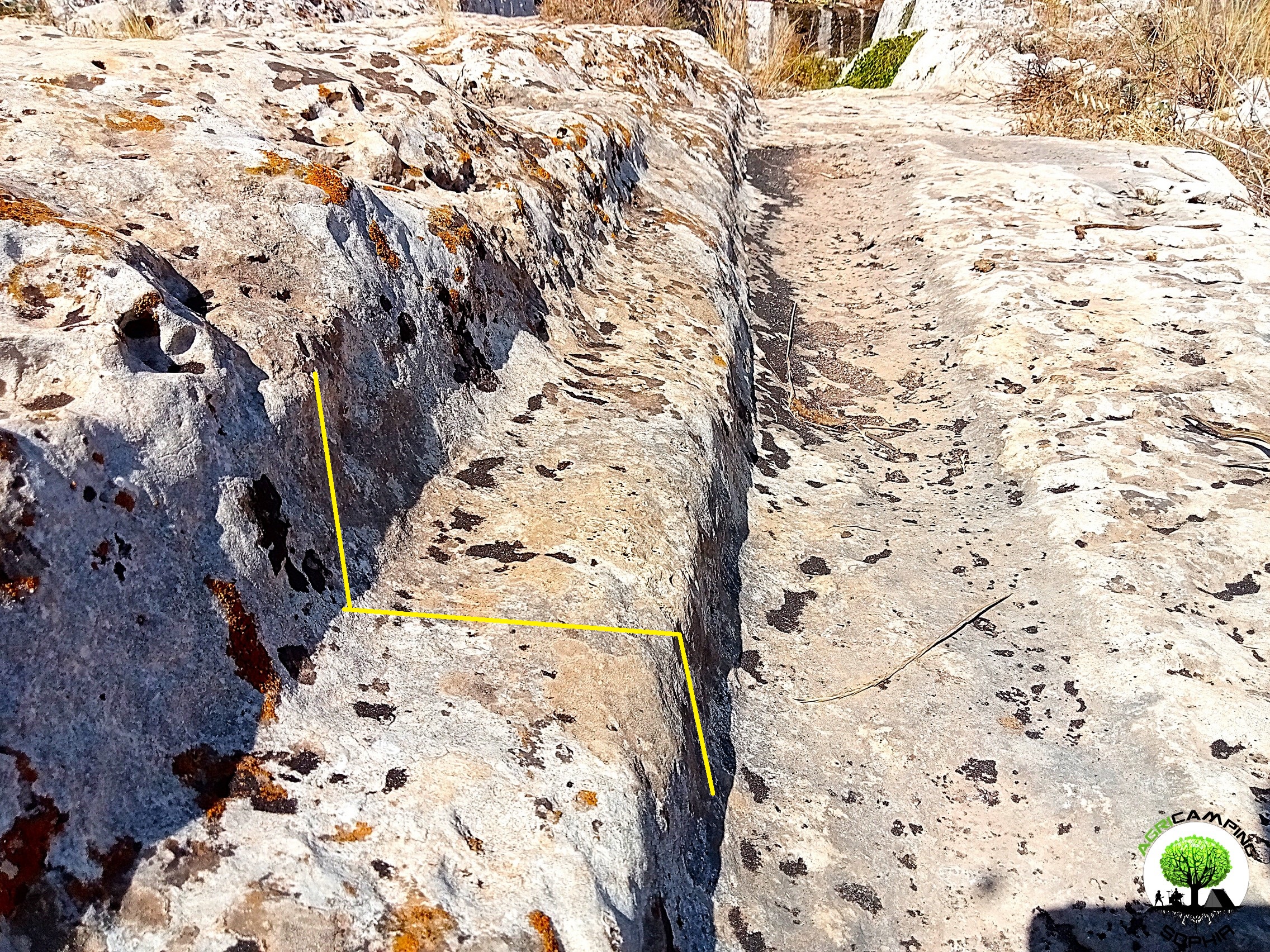 THE PROBLEMATIC EDGES OF THE CART RUTS
THE PROBLEMATIC EDGES OF THE CART RUTS
I will skip any preamble, referring to to what has already been written regarding the presence of cart ruts in south-eastern Sicily.As can be seen in other sites around the world, in some cart ruts I visited, in particular in the Cugni district in Pachino, in the Granati Vecchi district in Rosolini and in the Targia district in Syracuse, a clear border can be seen, a sort of frame, next to the grooves, more marked externally, barely noticeable internally.
The borders I measured have a width of 14-20 centimeters and a height of 8-10 centimeters.
Not all cart ruts have such frames present or particularly evident, regardless of the degree of wear or degradation. They are found above all in cart ruts with less deep grooves.
As already described in detail, given the presence of furrows with a depth of even 65-70 centimeters, the wheels of a possible vehicle would have had to have a...
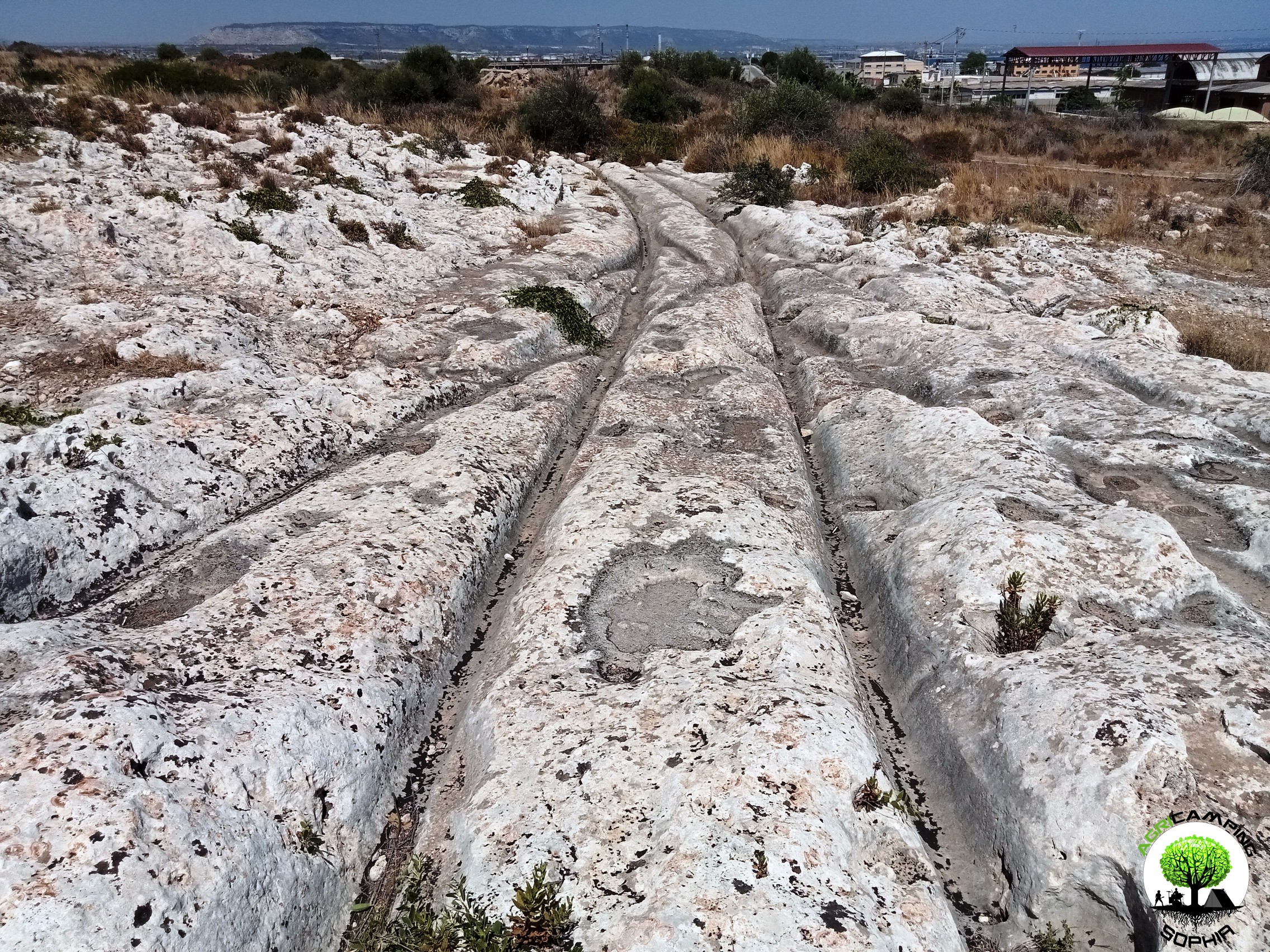 THE PROBLEM OF CART RUTS IN SOUTH-EASTERN SICILY (PART FOUR)
THE PROBLEM OF CART RUTS IN SOUTH-EASTERN SICILY (PART FOUR)
Click here to return to third part
Clapham Junction
As in the Maltese site Misrah Ghar Il-Kbir, also in the Targia and Granatari Vecchi districts the cart ruts intersect and cross each other in a similar way to the track switches in a railway station. The nickname Clapham Junction that was given by David H. Trump to the Maltese site, derives precisely from the similarity with the famous English railway station. For Sagona these are agricultural furrows and water channels, for Mottershead, Pearson and Schaefer these are abandoned paths due to obstacles and wear. Obviously we do not know what the morphology of the Syracuse and Rosolini territory was at times when the cart ruts were traced, but considering the current context, there certainly would have been no agricultural reason to build them, given the presence of fertile land, springs and fresh water courses just a few kilometers...





 DO YOU WANT TO ORGANIZE AN ERASMUS AT AGRICAMPING SOPHIA?
DO YOU WANT TO ORGANIZE AN ERASMUS AT AGRICAMPING SOPHIA? CART RUTS MODELED ON SOFT ROCK?
CART RUTS MODELED ON SOFT ROCK? RACK OR HOUSING FOR CLOGS?
RACK OR HOUSING FOR CLOGS? CART RUTS CUT FROM QUARRIES
CART RUTS CUT FROM QUARRIES CART RUTS AND A FEW TOO MANY PROJECTIONS
CART RUTS AND A FEW TOO MANY PROJECTIONS THE POLISHING OF THE CART RUTS
THE POLISHING OF THE CART RUTS THE PROBLEMATIC EDGES OF THE CART RUTS
THE PROBLEMATIC EDGES OF THE CART RUTS THE PROBLEM OF CART RUTS IN SOUTH-EASTERN SICILY (PART FOUR)
THE PROBLEM OF CART RUTS IN SOUTH-EASTERN SICILY (PART FOUR)